Footpaths form the backbone of our walking networks. Footpaths may run alongside the road or through parks and other open spaces, and include overbridges and subways. Well located and designed footpaths encourage walking and ensure a more equitable transport network.
Footpath “means a path or way principally designed for, and used by, pedestrians; and includes a footbridge” in the Traffic Control Devices Rule definitions. Users will include pedestrians of various abilities, users of wheeled recreational devices, and users of mobility scooters.
Clause 11.1 of the Land Transport (Road User) Rule 2004(external link) defines the use of footpaths:
(4) A driver of a mobility device or wheeled recreational device on a footpath—
(a) must operate the device in a careful and considerate manner; and
(b) must not operate the device at a speed that constitutes a hazard to other footpath users.
(5) A person using a wheeled recreational device on a footpath must give way to pedestrians and drivers of mobility devices.
(6) A pedestrian must not unduly impede the passage of—
(a) a mobility device or wheeled recreational device permitted to use the footpath by this clause…
At present, micro-mobility devices such as electric scooters are classified as wheeled recreational devices and are permitted to use footpaths. The Accessible Streets package of rule changes is likely to result in definition changes and/or the setting of additional rules governing the use of footpaths such as speed limits. In any event, footpaths that are wider, smoother, and with better geometric alignments will provide a better user experience for all users.
Traffic Control Devices Rule 2004
Land Transport (Road User) Rule 2004
The table below is a guide to providing footpaths in urban and rural environments.
Table: When to provide footpaths
| Land use | Footpath provision | |||
|---|---|---|---|---|
| New roads | Existing roads | |||
| Preferred | Minimum | Preferred | Minimum | |
| Commercial and industrial | Both sides | Both sides | ||
| Residential (on arterials) | ||||
| Residential (on collector roads) | ||||
| Residential (on local streets) | Both sides | One side | ||
| Three to 10 dwellings per hectare | Both sides | One side | One side | Shoulders on both sides |
| Fewer than three dwellings per hectare (rural) | One side | Shoulders on both sides | ||
Originally sourced from: ITE (1998) Design and safety of pedestrian facilities(external link)
Where only the minimum provision is made, the road controlling authority (RCA) should be able to demonstrate clearly why walking is not expected in that area (although for new or improved developments, this is the developer’s responsibility). Retrofitting footpaths is more costly than providing them in the first place, so the preferred standard should be installed for any new or improved development, unless:
For new developments, project timetables can sometimes mean footpaths are not proposed at the initial stages but are shown in the Master Plan or Outline Development Plan.;
In these cases, the RCA can reasonably request a written agreement from the developer to provide footpaths in future, potentially with a bond payment.[2]
There are some situations where pedestrians share the space with other road users. These are discussed in the Streets and places section.:
Most footpaths within the road reserve lie between the edge of the roadway and the frontage of adjacent private property. There are four distinct zones within this area (refer to the table below) and it is important to distinguish between the total width and the width of the footpath through zone. The through zone should be a dedicated, continuous and accessible route free of obstruction that can accommodate peak pedestrian demands.
|
The continuous accessible path of travel (footpath through zone) defines the area where the pedestrian route is safe and convenient for everyone, especially people with impaired mobility, and people who are blind or have low vision. It has even surfaces, gentle slopes and is kept free of permanent and temporary obstacles at all times. The edges of the zone are usually defined by adequate cues. In retail areas the continuous accessible path of travel is normally located next to the building line, which is likely to be the main orientation cue followed by people who are blind or have low vision. Street furniture such as parking meters and rubbish bins should be located near the kerb. Where retailers have limited space, well-designed outdoor facilities can be provided directly outside the building. If deviation (i.e. non-straightness) of accessible routes is unavoidable, a clear and simple transition should be provided. In residential streets the edges of the continuous accessible path of travel are usually adequately defined by the edges of the sealed footpath. |
When determining the width of the frontage or street furniture zone, a ‘shy distance’ of 0.15 m should apply from any object next to the footpath through zone. This area should then be excluded from the footpath through zone width as it is unlikely to be used by pedestrians. For example, if a lamp post is near the footpath through zone, the shy zone would be the area next to it. This area would then be included in the zone where the lamp post is located, and the through-route width would be reduced.
In off-road environments the same principles apply, however, one or more of the zones in the Table below may be absent or duplicated on the opposite side of the footpath through zone. The figure illustrates some arrangements for these zones.
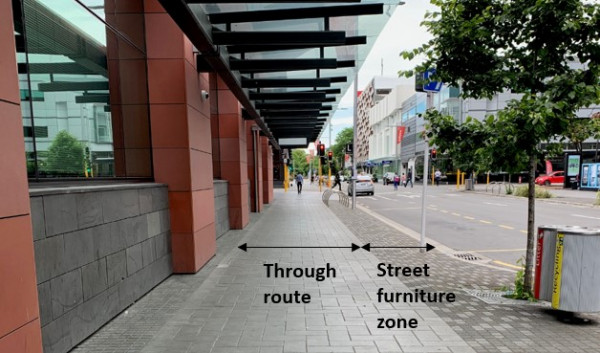
Footpath zone layout example.
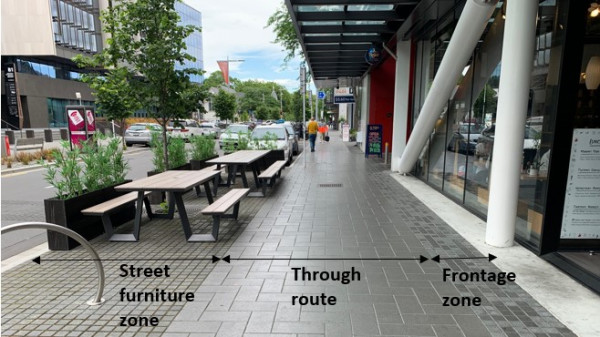
Footpath zone layout example.
Table: Zones of the footpath
| Area | Purpose |
|---|---|
| Kerb zone |
|
| Street furniture zone |
|
| Footpath through zone |
|
| Frontage zone |
|
Below are examples of good and poor practice:
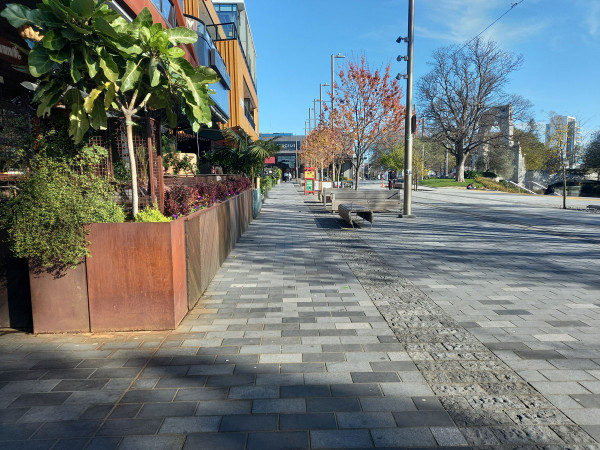
Good practice – street furniture is located in an enclosed area which can readily be detected by the use of a long cane. (Photo: Jeanette Ward)

Poor practice – street furniture that sprawls out onto the footpath is a hazard for all pedestrians. Note the umbrella at head height, which also poses a potential hazard. (Photo: Tim Hughes)
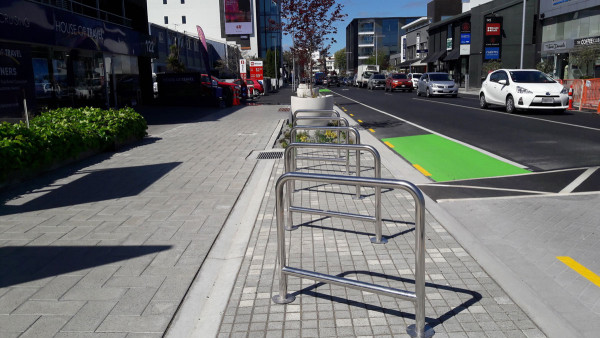
Good practice – street furniture zone used for cycle parking and landscaping buffer. (Photo: Jeanette Ward)
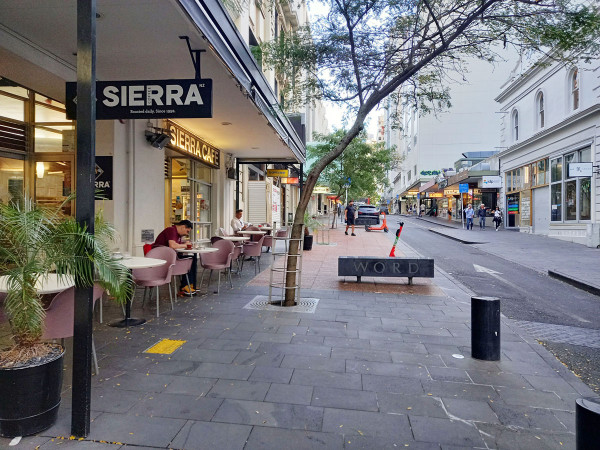
Poor practice – street furniture and other objects do not allow a clear through route and are a hazard to pedestrians. (Photo: Jeanette Ward)
[1] Standards New Zealand (2010) Land Development and Subdivision Infrastructure; NZS 4404:2010, Section 1.9.